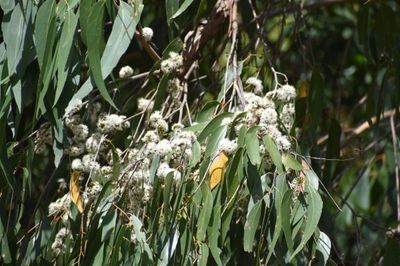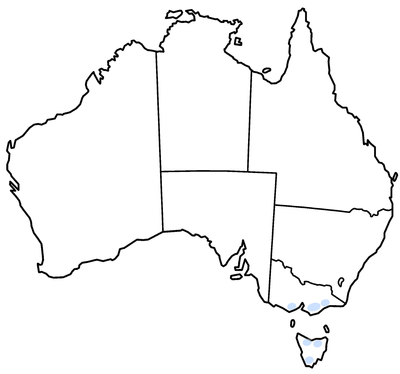



Eucalyptus regnans
Eucalyptus
Eucalyptus regnans, known variously as mountain ash, swamp gum, or stringy gum, is a species of medium-sized to very tall forest tree that is native to Tasmania and Victoria, Australia. It is a straight-trunked tree with smooth grey bark, but with a stocking of rough brown bark at the base, glossy green, lance-shaped to curved adult leaves, flower buds in groups
of between nine and fifteen, white flowers and cup-shaped or conical fruit. It is the tallest of all flowering plants; the tallest measured living specimen, named Centurion, stands 100.5 metres tall in Tasmania.
It often grows in pure stands in tall wet forest, sometimes with rainforest understorey, and in temperate, high rainfall areas with deep loam soils. A large number of the trees have been logged, including some of the tallest known. This species of eucalypt does not possess a lignotuber and is often killed by bushfire, regenerating from seed. Mature forests dominated by E. regnans have been found to store more carbon than any other forest known. The species is grown in plantations in Australia and in other countries. Along with E. obliqua and E. delegatensis it is known in the timber industry as Tasmanian oak.
Eucalyptus regnans is a broad-leaved, evergreen tree that typically grows to a height of 70–114 m but does not form a lignotuber. The crown is open and small in relation to the size of the rest of the tree. The trunk is straight with smooth, cream-coloured, greyish or brown back
with a stocking of more or less fibrous or flaky bark that extends up to 5–20 m at the base. The trunk typically reaches a diameter of 2.5 m at breast height (DBH). Young plants and coppice
regrowth have glossy green, egg-shaped leaves that are held horizontally, 55–120 mm long and 22–50 mm wide and petiolate. Adult leaves are arranged alternately along the stems, the same shade of glossy green on both sides, lance-shaped to broadly lance-shaped or sickle-shaped, 90–230 mm long and 15–50 mm wide, tapering to a reddish petiole 8–25 mm long. The upper and lower surfaces of the leaves are dotted with numerous tiny, circular or irregularly-shaped oil glands. Secondary leaf veins arise at an acute angle from the midvein and tertiary venation is sparse.
The flower buds are arranged in leaf axils in groups of between nine and fifteen on one or two unbranched peduncles 4–14 mm long, the individual buds on pedicels 3–7 mm long. Mature buds are oval, 4–7 mm ong and 2–4 mm wide with a rounded operculum. Flowering occurs from March to May and the flowers are white. The fruit is a woody, cup-shaped or conical capsule
5–8 mm long and 4–7 mm wide on a pedicel 1–7 mm long and usually with three valves near the level of the rim. The seeds are pyramid-shaped, 1.5–3 mm long with the hilum at the end.Seedlings have kidney shaped cotyledons, and the first two to three pairs of leaves are arranged in opposite pairs along the stem, then alternate.
255.00 Location Many specimens form part of the Tarwin River bank restoration plantings. Planted in 2021.

